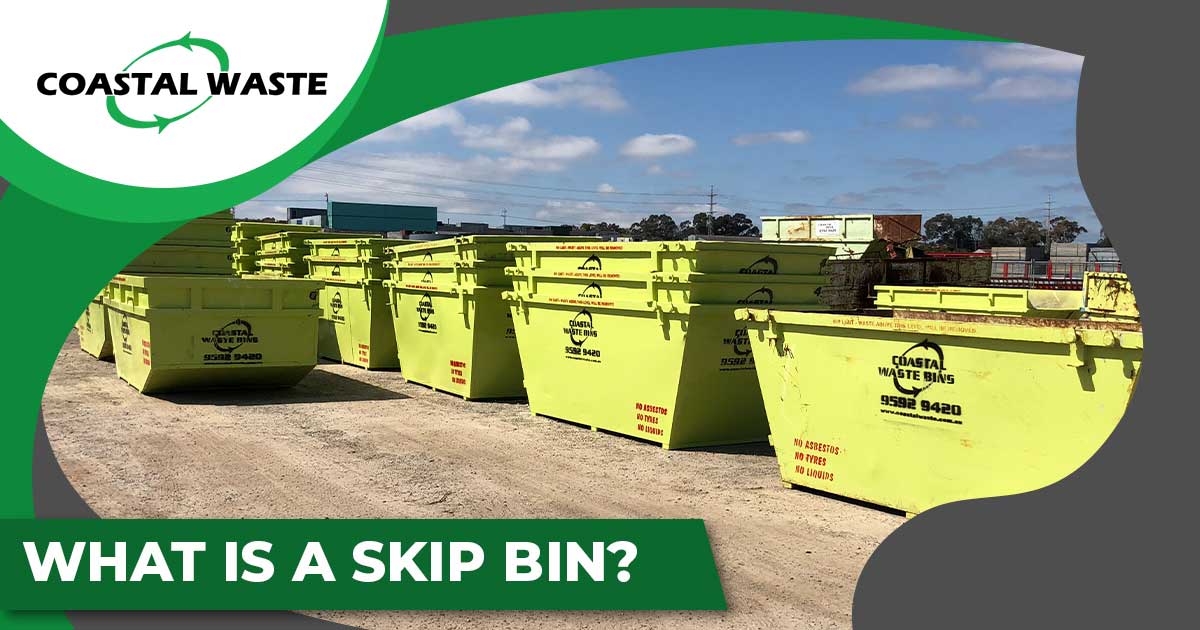
A skip bin is a large open-topped container designed for waste collection. It is often simply called a “skip” or even a “garbage skip” in some regions.
It is also designed for loading onto a special type of truck. So it can be easily transported for waste disposal.
They look like big metal boxes. Think of it as a massive trash can, but it is way more versatile.
Skip bins are used for various types of waste, including construction debris, household waste, green waste, and industrial waste.
You’ve probably heard of or seen skip bins. This large container is often spotted in driveways, construction sites, or bustling neighbourhoods during a major clean-up.
Whether people are renovating their homes, clearing out an office, or having a lot of rubbish to dispose of, a skip bin is usually the go-to solution.
In Australia, skip bins play a pivotal role in efficient waste management, helping communities and businesses keep their surroundings clean and organized.
Skip Meaning
Why it’s called a “skip”? The term originates from the Old Norse word “skeppa“, which means “basket”.
That word shows us how long ago, people used baskets to pick up waste. So it’s not just a random name; it has roots in history.
Over time, it evolved to represent these large waste containers we see today. These modern bins are way bigger and stronger than the old baskets.
It shows how we’ve changed our ways to handle more and more trash over time.
How Skip Bins Work
When you hire a skip bin, it is delivered to your location and placed in a suitable spot for loading.
Once filled, it is collected by the skip bin provider and the waste is taken to a transfer station or landfill for disposal.
Many skip bins incorporate a rear-hinged door, making it easier to load heavy or bulky items.
Skip Bin Placement
The placement of the skip bin is crucial. It must be accessible for loading but also positioned to avoid disrupting traffic or pedestrian pathways.
In some areas, placing a skip bin may require an obstruction permit from the government. It ensures that the bin does not interfere with public use or safety regulations.
A reliable provider should have this permit for their daily operations. So the placement complies with local laws and guidelines.

Why Hire a Skip Bin?
Opting for a skip bin isn’t just about convenience. Hiring a skip bin stands out for a multitude of reasons. Here’s why:
- Convenience — No need for multiple trips to the dump; just fill it up and have it collected.
- Eco-friendly — Proper disposal ensures waste doesn’t harm the environment.
- Versatility — Suitable for a range of waste types, from household junk to construction debris.
- Space-saving — Centralizes all your waste, freeing up space in your surroundings.
- Cost-effective — Often more affordable than other waste removal methods, especially for larger projects.
In essence, skip bins offer a blend of practicality and responsibility. It is a top choice for both individuals and businesses looking to manage waste efficiently.
Size of Skip Bins
Skip bins come in various sizes. The size you choose often depends on the volume of waste and the type of job.
Typically, the size range of skip bins are 2m³, 3m³, 4m³, 6m³, 8m³, 10m³, 12m³, 15m³, 20m³, 25m³, and 30m³.
The smaller sizes (mini skip bins) are perfect for small clean-ups like garden trimmings, minor home renovations, or clearing out a single room.
The larger bins can handle tasks such as major construction debris, whole-house clear-outs, or large-scale landscaping projects.
To see the details on the skip bin size dimensions, see this page.
What Can I Put in a Skip Bin?
Skip bins are versatile. They accommodate different types of waste such as general rubbish, bricks, concrete, soil, metal (scrap metal), furniture, soil, dirt, and even sand.
Overall, general waste, green waste, and building materials are usually fine.
However, hazardous items like batteries, chemicals, and asbestos are typically a no-go. Always check with your provider to avoid any violations of environmental health regulations.
Using Skip Bins for Soil, Dirt, and Sand Waste
When you use skip bins to remove soil, dirt, or sand, the waste is typically taken to a designated disposal facility or landfill.
Soil, dirt, and sand are often classified as inert waste. They can be used for purposes such as landfill cover or land reclamation, depending on local regulations and environmental considerations.
In Western Australia, for example, landfills do accept soil, dirt, and sand waste, but with specific conditions. The document Landfill Waste Classification and Waste Definitions outlines that these materials must be classified as clean or uncontaminated fill. This means they must come from areas not subject to potentially contaminating land uses like industrial or mining activities.
Traditional Rubbish Removal vs. Skip Bins
Traditional rubbish removal involves collecting waste bit by bit, often with multiple trips involved. Skip bins, on the other hand, offer a one-and-done solution.
While both have their merits, skip bins often stand out in terms of efficiency and cost-effectiveness.
Skip bin is all about convenience. Simply hire a bin, fill it up, and have it collected. No fuss, no hassle. It’s especially handy for big projects where waste accumulates quickly.
Skip Bin Uses Beyond Just Garbage
Believe it or not, skip bins aren’t just for trash. Some folks use them for storage during moves or renovations.
Others have even transformed them into makeshift swimming pools or art projects! The possibilities are as vast as your imagination.
Skip bins, with their simplicity and efficiency, have revolutionized waste management.
Whether you’re a homeowner, a business, or just someone with a lot of junk, using a skip bin hire service can make your life a whole lot easier.

